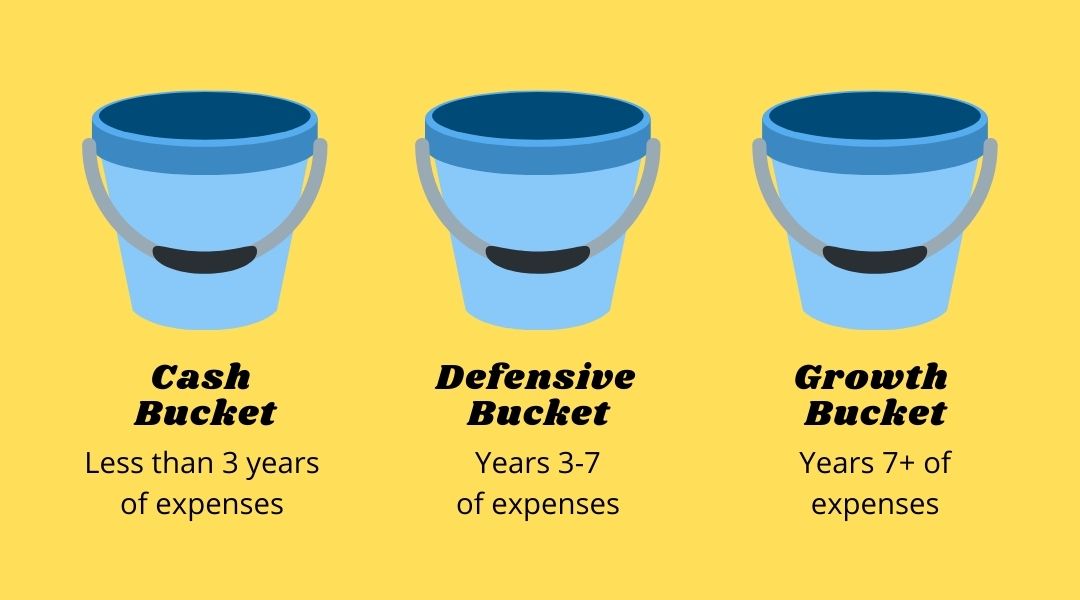Investing for retirement- part two: the bucket strategy

This blog post is the second in a series titled ‘Investing for retirement’. If you haven’t already, please check out ‘Investing for retirement- part one: understanding your investments’.
How should you invest for retirement?
In part one of this blog series, I explained why you need to select the investment option in your superannuation and why this is particularly relevant as you approach retirement.
I further broke down how ‘lifecycle’ investments work and how specifically they can change your investment strategy in a way that potentially costs you a lot of money.
In this blog post, I’ll explain how we think about investing for our clients approaching retirement.
Understanding your retirement
Each person’s retirement looks different. For some people, they are going to need a lot of money up-front. For others, they have investments outside of super and will draw on these before having to access their super.
Understanding what your retirement looks like helps you to plan your investments. But it’s important to not think of your superannuation as one big lump of money.
Retirement may last 30 years or greater and you will need different investments for different time frames. This is where we tend to recommend the bucket strategy.
The Bucket Strategy
The bucket strategy was pioneered by US financial planning expert Harold Evensky in 1985. The strategy is designed to balance the need for income stability with capital growth during retirement.
The bucket strategy divides a retirement portfolio into three buckets:
- Cash bucket- for short term expenses (usually up to 3 years)
- Defensive bucket- for medium term expenses (usually 3-7 years)
- Growth bucket- for long term expenses (usually 7 years +)
How much is in each bucket depends on your annual expenditure, your need for lump sums (for example if you needed to buy a car) and general market trends. Each bucket has a purpose which I’ve addressed below.

Cash Bucket
It seems obvious but when you do retire, you no longer receive a salary. This means that you need to draw on your investments/savings like a salary.
As a general rule, you shouldn’t invest money you need immediate access to. This is the purpose of a Cash Bucket.
In usual circumstances, this would sit in a high interest bank account or other low-risk style of investment and you would draw on it to fund lifestyle expenses. Some people prefer to take a wage similar to when they were employed whereas others are happy to draw on their savings as needed. However you choose to manage your money, this will come from your Cash Bucket.
Defensive Bucket
The purpose of the Defensive Bucket is to hold investment money you’ll need in the medium term (usually 3-7 years). This would usually consist of ‘defensive’ investments such as fixed interest products (including bonds).
The purpose of this bucket is to earn a small return whilst keeping risk to a minimum.
Growth Bucket
The Growth Bucket holds investment money which is designated to be spent in the long-term (greater than 7 years). This would largely consist of growth investments such as shares or property. This bucket has the potential to achieve the greatest return but will go up and down in value in the short-term more than the other buckets.
Rebalancing the buckets
The key to the bucket strategy is adjusting and rebalancing the buckets as you move through retirement. The idea is as you use up your Cash Bucket, you replenish this from the income received from your Defensive and Growth Buckets.
Further, if you need to draw on the capital to fund your lifestyle, you’ll need to sell down your Defensive Bucket (to go to your Cash Bucket) and your Growth Bucket (to top up your Defensive Bucket).
When you do this depends on your particular draw-down requirements and whether the market is performing well or not.
Whilst this ‘waterfall’ arrangement is the traditional way of viewing this strategy, I have a slightly different approach.
As a general rule, I prefer to take from the Growth Bucket to fund the Cash Bucket. This means that you take what you need at regular intervals regardless of market performance. The exception to this is in major bear markets such as the Global Financial Crisis (GFC). For those who can’t remember the GFC, this event saw markets drop by up to 60% in some places and took a number of years to recover.
My view of the Defensive Bucket is more akin to an insurance policy against the next GFC. Should markets drop significantly (30% or more) and you no longer wish to top up your Cash Bucket from your Growth Bucket, you have access to the Defensive Bucket with the hope that this will last until markets improve.
This can be challenging to determine when to use each bucket and is where the value of good advice can make a big difference.
Other strategies
There are many other strategies regarding investing during retirement and the bucket strategy is just one example. What is important to take from these blog posts is that investing for retirement is not set and forget. You should preferably start considering this at least 10 years prior to retirement to start preparing your buckets.
If you haven’t ever selected your investment option in your super, then make sure you take action today. As always, please reach out if you would like assistance in preparing a financial plan.





